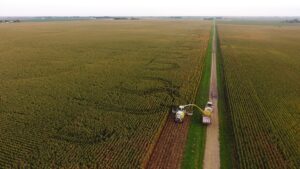 When it comes to harvesting and packing corn silage, quality depends on the factors of moisture, heat, air and time. Too much moisture, and you have seepage; not enough, and your silage will not ferment properly and mold could form. Sometimes it can feel like a huge balancing act. Kaitlyn Davis, UW Madison Division of Extension Agriculture Educator in La Crosse County has prepared the following considerations to keep in mind.
When it comes to harvesting and packing corn silage, quality depends on the factors of moisture, heat, air and time. Too much moisture, and you have seepage; not enough, and your silage will not ferment properly and mold could form. Sometimes it can feel like a huge balancing act. Kaitlyn Davis, UW Madison Division of Extension Agriculture Educator in La Crosse County has prepared the following considerations to keep in mind.
First, let’s talk about moisture. Recommended moisture levels vary from one silo type to the next. The following recommendations for moisture content for corn silage come from the University of Wisconsin-Madison Agronomy website:
- upright silos, 60% to 65%
- upright oxygen-limiting silos, 50% to 60%
- horizontal silos, 65% to 70%
- ag bags, 60% to 70%
Depending on the silo, you might have a bit more wiggle room when it comes to silage moisture.
How do you determine if silage is at the right moisture? If you don’t have a commercial forage-moisture tester handy, you can use a microwave oven to get a rough estimate of silage moisture before you harvest. The process for that is to weigh out 100 grams of freshly chopped silage, just like you would harvest, making sure to get a representative sample from the field on a paper plate. (Make sure to weigh the paper plate before weighing out 100 grams.)
Heat the silage for four minutes; then record its weight. Heat the silage again for one minute; then record that weight. Keep doing this until you get a consistent weight. That final number represents the dry matter in your corn silage. Take that number and subtract it from 100 to get an estimate of your corn’s moisture level. This process can be found on at: http://corn.agronomy.wisc.edu/Silage/S004.aspx
Air can play a major role in the quality of corn silage. Each silo structure relies on different packing methods. For example, if you are using silage bags, you will need to adjust bagging equipment correctly to pack the silage in tight versus an upright silo that uses the weight of the silage to pack it down. For bunkers and piles, make sure silage is not being put in faster than the packing tractors can pack it correctly. With the capacity of modern choppers, it is too easy to harvest faster than packing tractors can keep up with if not correctly planned for. More information on factors affecting bunker density can be found here: https://go.wisc.edu/x4l4c7
All silos will need to be correctly covered and sealed to keep oxygen out. An excess of oxygen can throw a monkey wrench into the fermentation process, creating uneven silage quality and significant nutrient loss.
The last consideration to discuss is timing. Remember to harvest and pack silos quickly to ensure the silage has proper time to ferment. This should also be done in a safe manner. Watch the weather, double-check equipment, be cautious of silo gases, and be aware of your surroundings. When people work in haste, mistakes can be made and injuries can happen.
For a deeper dive into corn silage harvest and packing management to reduce loss, visit the Division of Extension Forage Team website at https://fyi.extension.wisc.edu/forage/
Written by: Bill Halfman, Extension Monroe County, Agriculture Agent, email: william.halfman@wisc.edu
For more information, please contact: Carolyn Ihde, Agriculture Agent, Extension Richland County by email: carolyn.ihde@wisc.edu




